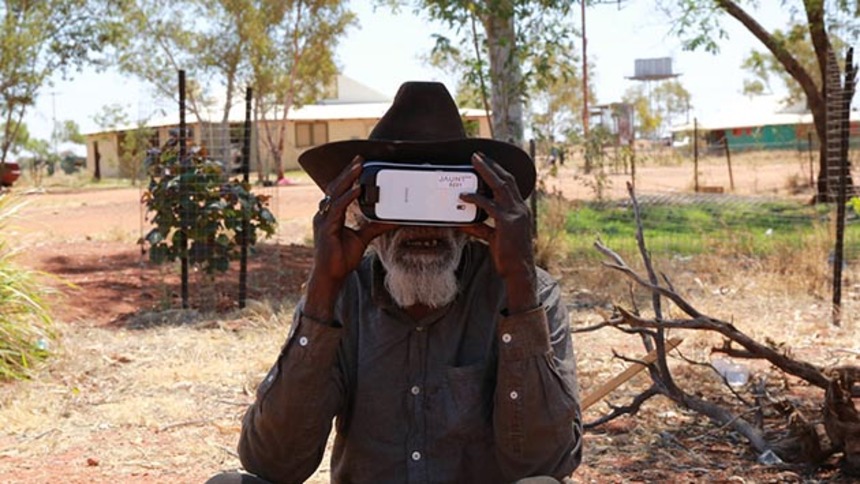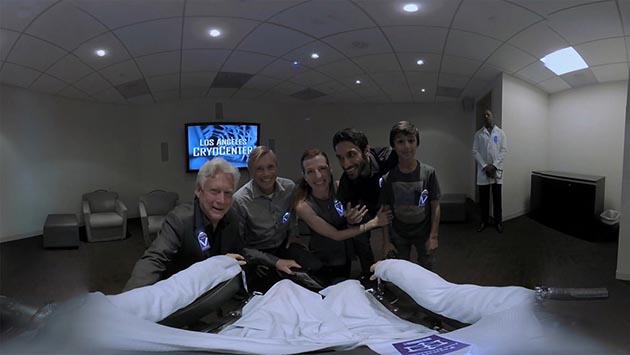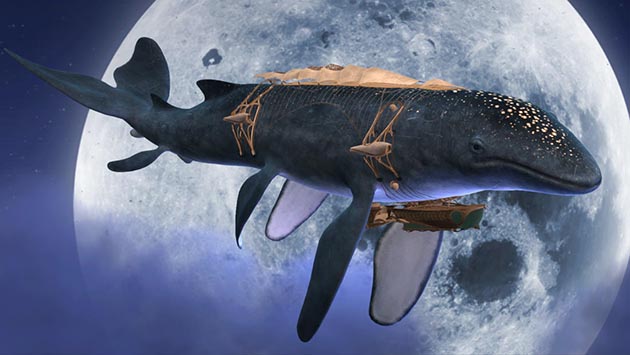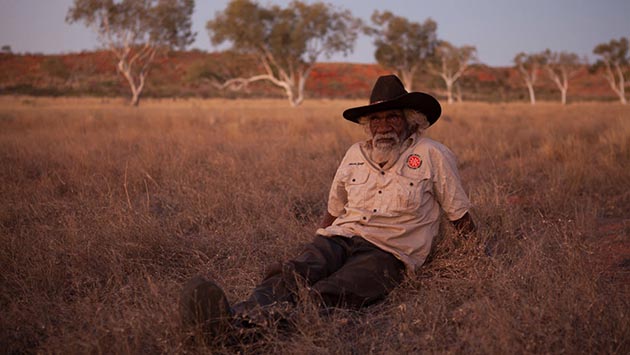Sundance 2016: New Frontier VR Round-Up

There is no doubt that we are right on the doorstep of the era of Virtual Reality. But VR has been a mainstay of the Sundance Film Festival for a number of years now. In particular, the New Frontier section has been on the forefront of VR exhibition, and in this, its 10th Anniversary, the program was bigger than ever before. With consumer products like the Samsung Gear VR out now and HTC Vive and Oculus Rift coming later this year, Sundance is the best place to take a survey of what VR artists are up to right now.
Of the over 35 VR "experiences" at the festival, I was able to try some 23 of them. These pieces ranged from tech demos to proto-narratives to sandbox experiences to gamified stories to first person documentaries. There was even a couple that could be classified as bona-fide narratives, or at least the very first acts of them.
You're not alone if you are a bit confused by some of these classifications. Terminology is one of the many aspects of virtual reality still finding its feet. Sundance's New Frontier press release categorized the experiences into "Documentary VR" and "Narrative VR," while a third category of "Installations" also included VR pieces. However those distinctions were completely absent at the actual New Frontier locations. The official program available there delineated between "Mobile VR," "Tethered VR," and "Art." Hmm.
Another important aspect of VR that causes problems for film festival programmers is the entire element of exhibition. Quite frankly, a crowded room full of people chatting, gawking, and perhaps even partying is just about the worst way to experience VR. The key word in VR is immersion and hearing other people talking - especially if they're talking to or about you - is completely distracting. A few of the pieces such as Giant and some of the HTC experiences did have enclosed or partially enclosed spaces, which helped, but the answer to how to demonstrate a VR piece to a lot of people remains elusive. That's also to say nothing for the lines. Lines may be a part of any film festivals, but they present a large problem for VR when demand is heavy and headsets scarce. To their credit, the New Frontier staff did an excellent job of giving people appointments, texting them when it was their turn, and moving people through the experiences quickly (not an easy task when someone needs to be on hand to start and stop each and every experience).
While these issues present challenges, probably the most glaring aspect of these early days of VR is that we just don't know how to tell stories in VR yet. Cinema has enjoyed over a century of evolution and we understand the language of the flat screen intimately. We're only at the Lumiere's Train Pulling into a Station days of VR. It's going to take a lot more experimentation before we can really define the grammar of VR storytelling,
With that in mind, how did the class of Sundance 2016 experimenters do? For the most part, quite well - at least as far as compelling pieces go. There were many interesting and exciting experiences to be had at New Frontier. While they stopped short of the killer app narrative, there is plenty to be excited about. Here are the details:

Of my 21 VR experiences, the one that came the closest to a full-on VR narrative was Randal Kleiser's Defrost (with Tanna Frederick). Kleiser, famous as the director of the film Grease, brought a filmic sensibility to his piece that began with the casting of talented and recognizable actors (Carl Weathers and Bruce Davison to start). It's a simple first person narrative about a woman who awakens from cryogenic sleep to find her grown children surrounding her. Not much happens, but this is (quite obviously) just the first part of a multi-part series and points to potential for a real story. Defrost is a non-interactive (i.e. pre-rendered) 360 video piece that runs on the Gear VR. This simplest of setups may be one of the secrets to its narrative success.

Employing a very different tactic for immersion, The Leviathan Project (credited to Alex McDowell and Bradley Newman) includes a VR component that is fully interactive - going so far as to track your movement as you pick up brightly painted objects and turn handles with motion capture balls pasted to the top. To the casual observer, the person awkwardly performing these tasks looks ridiculous. But slip on the Oculus Rift headset and you're transported to the steampunk paradise of Scott Westerfield's young adult literature. Those same dials and doodads become the intricate interworking of a flying whale-ship where you fill the shoes of a scientist inventing new magical creatures. It's a blast to play around in this world and points to the excitement that awaits us in the future of site-specific VR experiences.

Undoubtedly the most impressive hardware on show was the HTC Vive headset. The handful of experiences that ran on Vive had the best visuals and enjoyed the most accurate interactivity. The immersion factor of both Irrational Exuberance (Ben Vance) and theBlu: Encounter (Jake Rowell, Ben Vance) was incredible. While neither had particularly strong narrative elements - the former finds you breaking out of a celestial egg to view a beautiful cosmos while the latter places you on the deck of a sunken ship as an 80-foot blue whale swims up to and around you - they both are completely gorgeous and fun as well.

On the documentary side, there was an obvious dichotomy between pieces that focused on informing and those that concentrated more on making the viewer feel. Collisions was one of the more informative pieces. Directed by Lynette Wallworth, this piece is notable as it is the first project to come out of the Sundance Institute New Frontier & Jaunt VR Residency Program. The experience itself is a mixture of imagery and narration that takes the viewer to the deep Australian outback where an indigenous elder explains the experience of witnessing the atomic weapon testing that took place there in the 1960s. The visuals are stunning, especially the drone footage that was developed specifically for this piece. Expect big things to come from Wallworth and future Sundance/Jaunt fellows as they continue to experiment with documentary storytelling.

Condition One, credited to Danfung Dennis, Casey Brown, and Phil McNally, takes a more experiential spin on the documentary VR format by placing the viewer up close and personal with numerous animals that are on the verge of extinction. There is something particularly thrilling about having a grizzly bear come right up and sniff your face, though some of the technical limitations of capture (i.e. splice lines) can cause a break in the artifice. Likewise, abortion doc Across the Line by Nonny de la Peña, Brad Lichtenstein, and Jeff Fitzsimmons implements an abrupt Immersive shift when it switches from non-interactive live action video outside an abortion clinic to 3D-rendered interactive figures yelling abuse. It's a startling transition - both because of the subject matter and the experimental narrative style.

VRSE's Waves of Grace (by Chris Milk and Gabe Arora) takes the approach of merging the informative with the immersive elements and the effect is very successful. Watching as doctors suit up and later bury Ebola victims really brings home the horror of the disease in a way a traditional cinematic documentary would struggle to do. It's no surprise that VRSE is on the forefront of this documentary format. Waves of Grace is available now on the Gear VR.

One of more immersive experiences on hand was also the most "gamified." In The Martian VR Experience (credited to Robert Stromberg and Ridley Scott) you take on the role of Matt Damon's Mark Watney where you have to pilot a rover through a series of obstacles and then blast off from the lander through outer space to the waiting arms of Jessica Chastain's Commander Melissa Lewis. It's a fun experience, aided greatly by the Dbox seat the tilts and rumbles based on what you do in the VR space. The Oculus pre-release headset is also a big upgrade from the Development Kit 2 units and adds greatly to the immersion. I had a palpable feeling of elation when I linked arms with Lewis and knew I wouldn't be floating in space for the rest of eternity.

I want to save a final word for one of the smaller narratives playing on the Gear VR. Janicza Bravo's A Hard World for Small Things is a very effective narrative experience that works because it plays with your expectations. What starts as a docu-style camera-in-a-car in South Central Los Angeles takes the viewer in an unexpected direction. It's worth giving it a watch to understand more about how these expectations are even more important in VR.
* * *
A few more VR titles experienced at Sundance's New Frontier 2016:
#100Humans by Daniel Schechter, Linc Gasking, Rainer Gombos - A bit of a tech demo, this project experiments with full body capture and includes an exciting moment high on a cliff.
Giant by Milica Zec - Go inside a bunker as a mother, father, and young daughter make up stories to explain the bombs dropping outside. This is at its most effective when the rumble seats are active.
Job Simulator by Alex Schwartz, Devin Reimer - Somewhere between a game and a tech demo, this experience lets you use the Vive's controllers to interact with all kinds of objects in a typical workplace cubicle. It's lighthearted and quite fun as you throw staplers and photocopy your disembodied hand.
The Rose and I by Eugene Chung, Jimmy Maidens, Alex Woo - There is a bit of narrative at play as you watch a boy interact with a flower on a beautifully rendered 3D sphere. This piece by Penrose Studios is impressive as it makes great use of the Vive's fully interactive space, allowing you to look at the sphere from all sides.
Sequenced by Emilie Joly, Sylvain Joly, Michaël Martin - Another first act of a longer narrative, this post-apocalyptic story unfolds in a mixture of flat anime-style sprites and well-rendered 3D world. The story points to interesting things but it's hard to know exactly where it's headed at this early stage.
Sisters by Robyn Gray, Andrew Goldstein, Michael Murdock - This proto-narrative lets you pick up a flashlight in a spooky room and try to find the dolls haunting a cartoony house.
Sonar by Alexander Maas, Dominik Stockhausen, Philipp Maas - Pilot a ship (well kinda) as it descends deep into an alien world. There are some elements of narrative here but mostly it's an experience, albeit a well-rendered one.
Stonemilker by Andrew Thomas Huang - This music video by Bjork and VRSE explores the line between live performance and art. We've got a ways to go until we fully understand that interaction.
The Unknown Photographer by Loic Suty, Osman Zeki, Claudine Matte - This "immersive documentary" allows you to walk around an astral-like plane with huge photographs from World War I. Some of the photos are interesting and the made-up narration shows another way to implement documentary techniques in VR. The piece is at its most affecting when it opens up from the claustrophobic confines to a larger scale, although it is obviously limited by many technical issues at this early stage.
Waves by Benjamin Dickinson, Reggie Watts, Luis Blackaller - One of the most smile-inducing experiences at New Frontier was this Reggie Watts VR music extravaganza. This is part Tron and part Strange Days. If that sounds awesome... it is.






